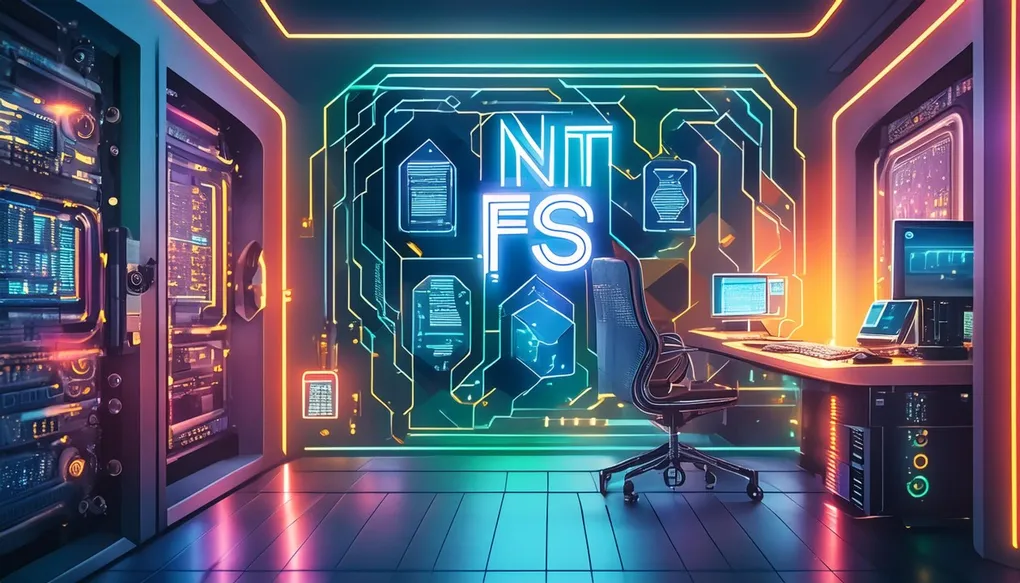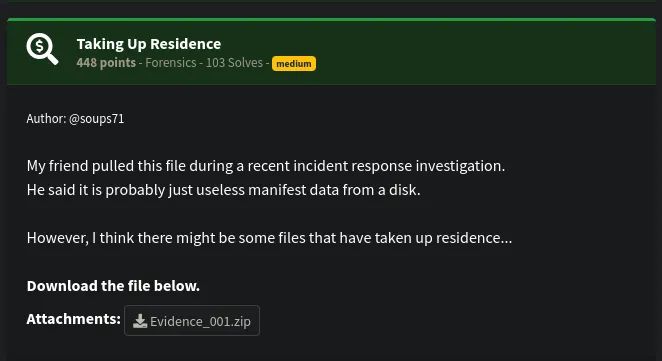
NahamCon CTF 2024 - Taking Up Residence
Moving all of my past CTF write-ups to this website…
Another fun one! This was the final challenge I completed before heading to bed… at 11am 🤔 — a satisfying finish to a satisfying CTF!
Challenge

A zip file!
┌──(kali㉿kali)-[~/Downloads/ev]
└─$ unzip -l Evidence_001.zip
Archive: Evidence_001.zip
Length Date Time Name
--------- ---------- ----- ----
418119680 2024-05-20 20:01 Evidence_001
--------- -------
418119680 1 fileWith a single file!
Analysis
┌──(kali㉿kali)-[~/Downloads/ev/_Evidence_001.zip.extracted]
└─$ file Evidence_001
Evidence_001: data
┌──(kali㉿kali)-[~/Downloads/ev/_Evidence_001.zip.extracted]
└─$ binwalk Evidence_001
DECIMAL HEXADECIMAL DESCRIPTION
--------------------------------------------------------------------------------
171335 0x29D47 mcrypt 2.2 encrypted data, algorithm: blowfish-448, mode: CBC, keymode: 8bit
476576 0x745A0 GIF image data, version "89a", 1 x 1
636719 0x9B72F mcrypt 2.2 encrypted data, algorithm: blowfish-448, mode: CBC, keymode: 8bit
637103 0x9B8AF mcrypt 2.2 encrypted data, algorithm: blowfish-448, mode: CBC, keymode: 8bit
743840 0xB59A0 GIF image data, version "89a", 1 x 1
789920 0xC0DA0 GIF image data, version "89a", 1 x 1
790944 0xC11A0 GIF image data, version "89a", 1 x 1
791968 0xC15A0 GIF image data, version "89a", 1 x 1
964040 0xEB5C8 XML document, version: "1.0"
1000872 0xF45A8 PNG image, 48 x 48, 8-bit/color RGBA, non-interlaced
1198496 0x1249A0 GIF image data, version "89a", 1 x 1Neither file nor binwalk know what it is though. What strings are there? Well, a lot, so here’s a sample.
┌──(kali㉿kali)-[~/Downloads/ev/_Evidence_001.zip.extracted]
└─$ strings Evidence_001 | grep bash
bash.txt
User\Desktop\bash.txt
set TZData(:Africa/Lubumbashi) $TZData(:Africa/Maputo)
#!/bin/bash
```bash
# add ~/.bash_profile if needed for executing ~/.bashrc
if [ -e ~/.bashrc -a ! -e ~/.bash_profile -a !
e ~/.bash_login -a ! -e ~/.profile ]; then
printf "\n\033[31mWARNING: Found ~/.bashrc but no ~/.bash_profile, ~/.bash_login or ~/.profile.\033[m\n\n"
echo "A ~/.bash_profile that loads ~/.bashrc will be created for you."
cat >~/.bash_profile <<-\EOF
test -f ~/.bashrc && . ~/.bashrc
#!/usr/bin/bash
#!/bin/bash
```bash
Before reporting a bug in bash-completion, please check that you don't have
Acrobat's acroread.sh installed in /etc/bash_completion.d/. That completion,
in fact, redefines internal bash-completion functions, breaking it.
instance, if 'man bash'
fails to display the bash(1) manual page correctly, I will usually want
to see the output of 'man --debug bash'.
# config file for bash-completionWe have what seems to be a whole bunch of different kind of stuff contained within! There are shebangs, shell scripts, file names, the contents of a .bashrc file, and documentation. 🤔🤔🤔🤔🤔 So some sort of an esoteric archive?
Also a quick note that I moved to Windows for the rest of this one.
Let’s take a look in a hex editor. Looking around, I could see somewhat of a pattern. Here’s part of one “entry”:
Offset(h) 00 01 02 03 04 05 06 07 08 09 0A 0B 0C 0D 0E 0F
00131400 46 49 4C 45 30 00 03 00 04 B1 54 CC 00 00 00 00 FILE0....±TÌ....
00131410 05 00 01 00 38 00 01 00 90 03 00 00 00 04 00 00 ....8...........
00131420 00 00 00 00 00 00 00 00 03 00 00 00 C5 04 00 00 ............Å...
00131430 02 00 FA 9D 00 00 00 00 10 00 00 00 60 00 00 00 ..ú.........`...
00131440 00 00 00 00 00 00 00 00 48 00 00 00 18 00 00 00 ........H.......
00131450 5C 9C 82 AA 16 A0 DA 01 DD 3F EE A0 0C AB DA 01 \œ‚ª. Ú.Ý?î .«Ú.
00131460 DD 3F EE A0 0C AB DA 01 DD 3F EE A0 0C AB DA 01 Ý?î .«Ú.Ý?î .«Ú.
00131470 20 00 00 00 00 00 00 00 00 00 00 00 00 00 00 00 ...............
00131480 00 00 00 00 59 06 00 00 00 00 00 00 00 00 00 00 ....Y...........
00131490 60 1D 5C 19 00 00 00 00 30 00 00 00 70 00 00 00 `.\.....0...p...
001314A0 00 00 00 00 00 00 02 00 52 00 00 00 18 00 01 00 ........R.......
001314B0 1A 59 01 00 00 00 01 00 5C 9C 82 AA 16 A0 DA 01 .Y......\œ‚ª. Ú.
001314C0 DD 3F EE A0 0C AB DA 01 DD 3F EE A0 0C AB DA 01 Ý?î .«Ú.Ý?î .«Ú.
001314D0 DD 3F EE A0 0C AB DA 01 00 00 00 00 00 00 00 00 Ý?î .«Ú.........
001314E0 00 00 00 00 00 00 00 00 20 00 00 00 00 00 00 00 ........ .......
001314F0 08 03 66 00 6C 00 61 00 67 00 2E 00 6C 00 6E 00 ..f.l.a.g...l.n.
00131500 6B 00 00 00 00 00 00 00 80 00 00 00 80 02 00 00 k.......€...€...
00131510 00 00 18 00 00 00 01 00 64 02 00 00 18 00 00 00 ........d.......
00131520 4C 00 00 00 01 14 02 00 00 00 00 00 C0 00 00 00 L...........À...
00131530 00 00 00 46 9B 00 20 00 20 00 00 00 2C 97 65 5E ...F›. . ...,—e^
00131540 0C AB DA 01 8B E3 26 97 0C AB DA 01 06 7B E6 96 .«Ú.‹ã&—.«Ú..{æ–
00131550 0C AB DA 01 8C 00 00 00 00 00 00 00 01 00 00 00 .«Ú.Œ...........
00131560 00 00 00 00 00 00 00 00 00 00 00 00 AA 00 14 00 ............ª...
00131570 1F 50 E0 4F D0 20 EA 3A 69 10 A2 D8 08 00 2B 30 .PàOÐ ê:i.¢Ø..+0
00131580 30 9D 3A 00 2E 80 05 39 8E 08 23 03 02 4B 98 26 0.:..€.9Ž.#..K˜&
00131590 5D 99 42 8E 11 5F 26 00 01 00 26 00 EF BE 11 00 ]™BŽ._&...&.ï¾..
001315A0 00 00 0D 29 F4 0D C7 11 D6 01 E3 73 13 C4 1D A0 ...)ô.Ç.Ö.ãs.Ä.
001315B0 DA 01 77 BF 79 52 09 AB DA 01 14 00 5A 00 32 00 Ú.w¿yR.«Ú...Z.2.
001315C0 8C 00 00 00 B4 58 D1 BA 20 00 66 6C 61 67 2E 74 Œ...´XѺ .flag.t
001315D0 78 74 00 00 42 00 09 00 04 00 EF BE B4 58 9D BA xt..B.....ï¾´X.º
001315E0 B4 58 D1 BA 2E 00 00 00 31 5F 00 00 00 00 04 00 ´XѺ....1_......
001315F0 00 00 00 00 00 00 00 00 00 00 00 00 00 00 02 00 ................
00131600 29 01 66 00 6C 00 61 00 67 00 2E 00 74 00 78 00 ).f.l.a.g...t.x.
00131610 74 00 00 00 18 00 00 00 4F 00 00 00 1C 00 00 00 t.......O.......
00131620 01 00 00 00 1C 00 00 00 2D 00 00 00 00 00 00 00 ........-.......
00131630 4E 00 00 00 11 00 00 00 03 00 00 00 3F 59 F1 20 N...........?Yñ
00131640 10 00 00 00 00 43 3A 5C 55 73 65 72 73 5C 55 73 .....C:\Users\Us
00131650 65 72 5C 44 6F 77 6E 6C 6F 61 64 73 5C 66 6C 61 er\Downloads\fla
00131660 67 2E 74 78 74 00 00 21 00 2E 00 2E 00 5C 00 2E g.txt..!.....\..
00131670 00 2E 00 5C 00 2E 00 2E 00 5C 00 2E 00 2E 00 5C ...\.....\.....\
00131680 00 2E 00 2E 00 5C 00 44 00 6F 00 77 00 6E 00 6C .....\.D.o.w.n.l
00131690 00 6F 00 61 00 64 00 73 00 5C 00 66 00 6C 00 61 .o.a.d.s.\.f.l.a
001316A0 00 67 00 2E 00 74 00 78 00 74 00 17 00 43 00 3A .g...t.x.t...C.:
001316B0 00 5C 00 55 00 73 00 65 00 72 00 73 00 5C 00 55 .\.U.s.e.r.s.\.U
001316C0 00 73 00 65 00 72 00 5C 00 44 00 6F 00 77 00 6E .s.e.r.\.D.o.w.n
001316D0 00 6C 00 6F 00 61 00 64 00 73 00 60 00 00 00 03 .l.o.a.d.s.`....
001316E0 00 00 A0 58 00 00 00 00 00 00 00 77 69 6E 64 65 .. X.......winde
001316F0 76 32 30 30 34 65 76 61 6C 00 00 FC BA 81 37 5D v2004eval..üº.7]
00131700 63 5A 44 96 6A B9 54 A6 86 1E D7 B0 F4 A5 06 17 cZD–j¹T¦†.×°ô¥..Each entry seems to begin with FILE0 and incidentally seems to be aligned,
probably due to padding at the end of each entry.
It’s hard to demonstrate without pasting an obnoxious amount of data,
but not every entry has any contents stored within, which is peculiar.
Well, I don’t know what this file is, so google to the rescue!
It’s hard to find good results, though,
since large file containing FILE0 entries and whatnot tend to bring up other results.
Googling 46 49 4C 45 30 00 03 — the byte sequence common to every entry —
showed me that this is an NTFS MFT (master file table).
Incidentally, the very first entry has a UTF-16 encoded file name $MFT,
which is kinda hard to spot when staring at a wall of hex 🤷.
Further googling brings us to the key MFTECmd 🔗! Here are the relevant parts of the help text:
C:\Users\GPUVM\Downloads\MFTECmd>MFTECmd.exe
Description:
MFTECmd version 1.2.2.1
Author: Eric Zimmerman (saericzimmerman@gmail.com)
https://github.com/EricZimmerman/MFTECmd
Usage:
MFTECmd [options]
Options:
-f <f> File to process ($MFT | $J | $Boot | $SDS | $I30). Required
--json <json> Directory to save JSON formatted results to. This or --csv required unless --de or --body is
specified
Example: 5, 624-5 or 0x270-0x5.
--dr When true, dump $MFT resident files to dir specified by --csv or --json, in 'Resident' subdirectory.Apparently some file table entries can contain actual files — resident files! I guess that’s what the challenge name refers to. This also explains why some entries had file data and some didn’t. Let’s dump the resident files and start looking around.
PS C:\Users\GPUVM\Downloads\MFTECmd\output\Resident> ls | select-string "flag\.txt"
1221-5_flag.lnk.bin:3:���s���w�yR ��Z2��XѺ flag.txtB
ᄡX���XѺ.1_��)flag.txtO-N?Y� C:\Users\Use
r\Downloads\flag.txt!..\..\..\..\..\Downloads\flag.txtC:\Users\User\
Downloads`�Xwindev2004eval���7]cZD�j�T��װ���'l�����7]cZD�j�T��װ���'l��E
�91SPS�mD��pH�H@.�=x�hH���@$
22910-3_flag.txt.lnk.bin:3:���s���w�yR ��f2�XN FLAGTX~1.TXTJ
ᄃXN�XN.}Y@;�flag.txt.txtS-R?Y� C:\
Users\User\Downloads\flag.txt.txt%..\..\..\..\..\Downloads\flag.txt.txtC:\
Users\User\Downloads
59966-5_untitled[1].py.bin:5:with open('flag.txt', 'r') as reader:Found an interesting file…
# PS C:\Users\GPUVM\Downloads\MFTECmd\output\Resident> gc '.\59966-5_untitled`[1`].py.bin'
from cryptography.fernet import Fernet
import subprocess
key = result = subprocess.run(["powershell", "-EncodedCommand", "RwBlAHQALQBDAG8AbgB0AGUAbgB0ACAALQBQAGEAdABoACAAIgByAGEAbgBzAG8AbQAuAHAAeQAiACAALQBTAHQAcgBlAGEAbQAgACIAawBlAHkAIgA="], capture_output=True, text=True).stdout.strip()
with open('flag.txt', 'r') as reader:
message = reader.read()
f = Fernet(key)
encrypted_message = f.encrypt(message.encode())We found a script that ultimately reads the flag and encrypts it with some key. It doesn’t seem to write it anywhere, but we’ll worry about that later. What about that base64?
PS C:\Users\GPUVM\Downloads\MFTECmd\output\Resident> [System.Text.Encoding]::UTF8.GetString([Convert]::FromBase64String(
"RwBlAHQALQBDAG8AbgB0AGUAbgB0ACAALQBQAGEAdABoACAAIgByAGEAbgBzAG8AbQAuAHAAeQAiACAALQBTAHQAcgBlAGEAbQAgACIAawBlAHkAIgA="))
Get-Content -Path "ransom.py" -Stream "key"That Stream we see here is an NTFS alternate data stream — a technique often used to hide malicious code/data from users.
It’s not actually that relevant for this challenge,
but I hadn’t personally run into NTFS alternate data streams in the wild in this way yet! It was fun to see.
In any case, let’s find ransom.py if we can.
PS C:\Users\GPUVM\Downloads\MFTECmd\output\Resident> gi *ransom.py*
Directory: C:\Users\GPUVM\Downloads\MFTECmd\output\Resident
Mode LastWriteTime Length Name
---- ------------- ------ ----
-a---- 5/25/2024 8:20 PM 46 97579-2_ransom.py.bin
PS C:\Users\GPUVM\Downloads\MFTECmd\output\Resident> gi *ransom.py* | gc
62QJTO5dH0xaKgmiVfOFKNYCBMfRiNF5L7rxDChc0SU=Seems like a key to me! What about the flag?
PS C:\Users\GPUVM\Downloads\MFTECmd\output\Resident> gi *flag.txt.bin*
Directory: C:\Users\GPUVM\Downloads\MFTECmd\output\Resident
Mode LastWriteTime Length Name
---- ------------- ------ ----
-a---- 5/25/2024 8:20 PM 140 24369-4_flag.txt.bin
PS C:\Users\GPUVM\Downloads\MFTECmd\output\Resident> gi *flag.txt.bin* | gc
gAAAAABmS9s32v5Ju181EaJhh2vYMsR6MJ31SK-9mDwgiCz3_MBWopjqqynjoY_-HNOw3tX1T3RthBZHz9ylmyqckZ0gUZ_6T7UUxprMHoCAaTV3m1q0weznBg98RL7dRVhRn0cX6XtaEven though the script didn’t appear to write out the encrypted contents, we seem to have retrieved some ciphertext. It’s probably best not to question things and just roll with it…
Solution
We can simply do the reverse of what the script does:
from cryptography.fernet import Fernet
key = b'62QJTO5dH0xaKgmiVfOFKNYCBMfRiNF5L7rxDChc0SU='
ciphertext = b'gAAAAABmS9s32v5Ju181EaJhh2vYMsR6MJ31SK-9mDwgiCz3_MBWopjqqynjoY_-HNOw3tX1T3RthBZHz9ylmyqckZ0gUZ_6T7UUxprMHoCAaTV3m1q0weznBg98RL7dRVhRn0cX6Xta'
f = Fernet(key)
print(f.decrypt(ciphertext))
# b'flag{a4096cd70d8859d38cf8e7487b4cd0fa}'There’s our flag! 🚩🚩